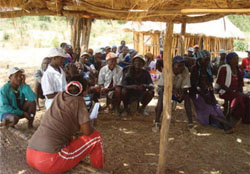
If you can identify specific barriers to immunization, you will need to decide which of these might be targeted in order to look for a solution. Which of these barriers might it be possible to remove? How might this help to increase immunization coverage and decrease dropout rates? Why are so many children not brought for immunization? Table 9.1 lists some commonly reported reasons.
| Reason why child not fully immunized | Caregivers giving this as the main reason (%) |
|---|---|
| Unaware of need for immunization | 22.8 |
| Unaware of need to return for next dose | 12.8 |
| Vaccine not available | 12.5 |
| Mother too busy | 6.3 |
| Vaccinator absent | 6.1 |
| Place and time of immunization unknown | 6.0 |
| Immunization site too far away | 5.7 |
| Family problems and/or mother ill | 5.3 |
| Fear of adverse effects following immunization | 4.0 |
| Time of session not convenient | 2.6 |
Stop reading for a moment and think about which of the reasons in Table 9.1 are the most likely reasons for children not being brought for immunization in your catchment area.
These are the issues that you should concentrate your communication efforts on, and that should form the basis of your communication objectives.
Which of the reasons listed in Table 9.1 do you think could be best addressed by improved communication? How might you hope to address these barriers to an effective immunization service?
Many of the reasons given in the table could be addressed by improved communication, but in particular you might have suggested:
You will recall from Study Session 8 that objectives always have to be specific and the outcomes must be measurable. A well-constructed objective identifies what will be done in order to achieve it, who will do it and where, what resources will be used, and the timescale in which the target should be achieved. You will also need to work out what resources are available in the community that can be used for the communication activities that you may wish to organise.
Having set your communication objectives, you next need to decide what activities would be the most appropriate to help you to achieve them. You should address the following questions:
There are a number of possible strategies or activities you can use to get your message across to the community. These might include a community conversation (Figure 9.3 and see Section 9.3.4 later in this study session) or a community mobilisation or advocacy programme. The work plan for conducting these activities should be realistic. You will need to think about what it is that you want to do, when you hope to do it, how many people you will need to help you and who these people might be.

You will also need to find ways to check whether your strategy or activity is working. For example, you might have held a meeting or conducted a community conversation to explain the advantages of immunization, and the seriousness of the diseases it protects against. You hope that this might increase immunization coverage by encouraging caregivers to bring their children to the Health Post for immunization.
How could you evaluate whether your message was understood and whether it has made a difference to people’s behaviour?
There are many possible ways you might try to evaluate the effectiveness of your activities. Here are some suggestions (you might have thought of others):
If you look back at Figure 9.1, you will see that it is a circle. This is because the results of your monitoring and evaluation help you to determine which strategies and activities are making progress towards achieving your objectives. This information should be fed back into your next communication analysis, so communication improves when you find out about people’s attitudes and behaviour next time.